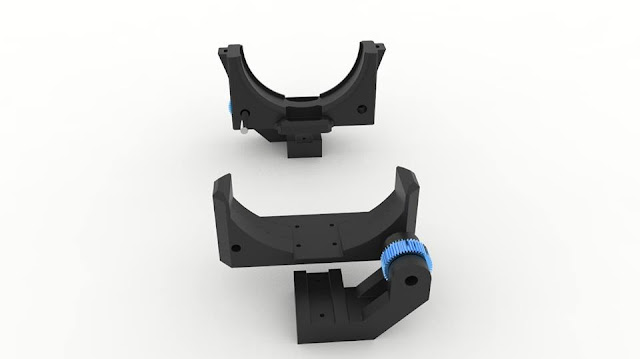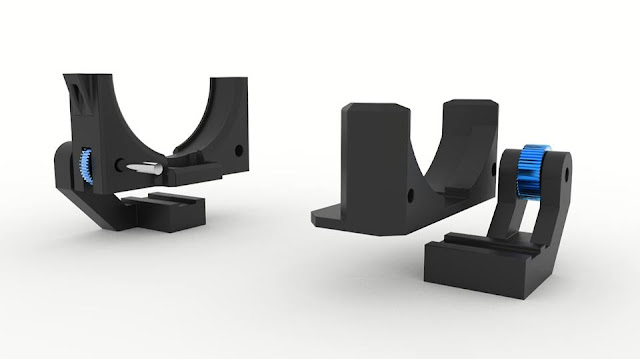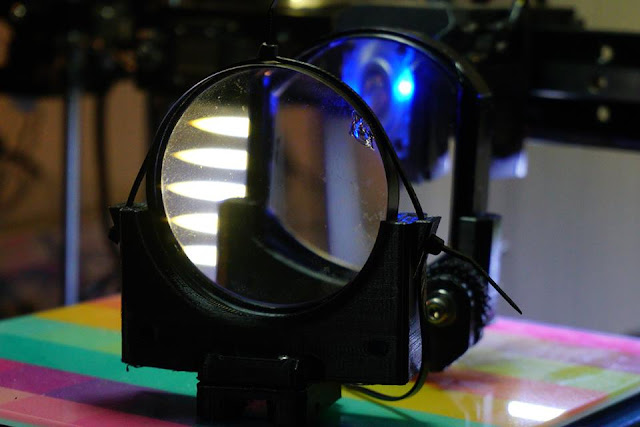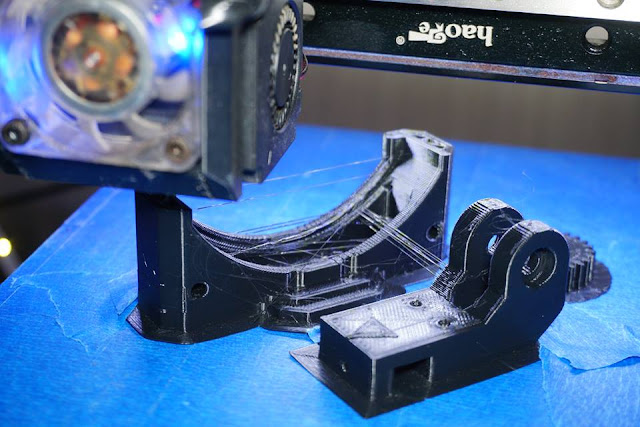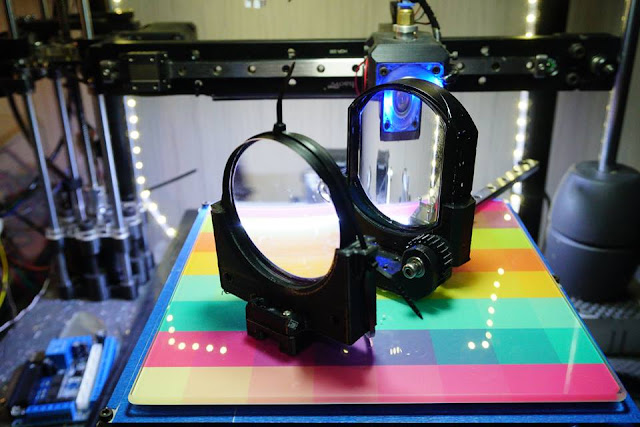precision positioning needed for shifting the position of lenses
Posted by gubehikupe
|
precision positioning needed for shifting the position of lenses February 11, 2018 10:14AM |
Registered: 6 years ago Posts: 7 |
Looking for a way to shift a 30mm len in two axis perpendicular to another lens. The lens is for shifting a video projection up, down, left, right. Basically what you will find in tilt-shift camera lenses or video projectors with motorized lens-shift feature.
The travel distance is very short, 1/4th of the 30mm lens diameter, but precision has to be at least 1024 steps across that 30mm/4 length.
Would love any ideas how to implement this. Can only think of a gantry based system but can’t find small enough motors. Speed is also a concern, needs to go from one edge to the next in 1/3 seconds.
Haven’t been able to teardown tilt-shift camera lenses or motorized video projectors to see how it is implemented there. But from experience they are very slow.
Edited 2 time(s). Last edit at 02/11/2018 10:15AM by gubehikupe.
The travel distance is very short, 1/4th of the 30mm lens diameter, but precision has to be at least 1024 steps across that 30mm/4 length.
Would love any ideas how to implement this. Can only think of a gantry based system but can’t find small enough motors. Speed is also a concern, needs to go from one edge to the next in 1/3 seconds.
Haven’t been able to teardown tilt-shift camera lenses or motorized video projectors to see how it is implemented there. But from experience they are very slow.
Edited 2 time(s). Last edit at 02/11/2018 10:15AM by gubehikupe.
|
Re: precision positioning needed for shifting the position of lenses February 11, 2018 10:22AM |
Admin Registered: 16 years ago Posts: 13,886 |
... think about "delocating" the motors and use wires to move the lens around - then you can use stronger (bigger) motors.
For higher speeds there are servos ... or (much more expensive) piezo-driven XY-positioners for microscopy or micro-assembly ...
Viktor
--------
Aufruf zum Projekt "Müll-freie Meere" - [reprap.org] -- Deutsche Facebook-Gruppe - [www.facebook.com]
Call for the project "garbage-free seas" - [reprap.org]
For higher speeds there are servos ... or (much more expensive) piezo-driven XY-positioners for microscopy or micro-assembly ...
Viktor
--------
Aufruf zum Projekt "Müll-freie Meere" - [reprap.org] -- Deutsche Facebook-Gruppe - [www.facebook.com]
Call for the project "garbage-free seas" - [reprap.org]
|
Re: precision positioning needed for shifting the position of lenses February 11, 2018 11:05AM |
Registered: 6 years ago Posts: 7 |
|
Re: precision positioning needed for shifting the position of lenses February 11, 2018 12:43PM |
Admin Registered: 16 years ago Posts: 13,886 |
... you can assemble a big XY stage beside or under the lense and build an XY-positioner for the lens, which is moved around by wires, wound around the motor axes or pulleys ...
Viktor
--------
Aufruf zum Projekt "Müll-freie Meere" - [reprap.org] -- Deutsche Facebook-Gruppe - [www.facebook.com]
Call for the project "garbage-free seas" - [reprap.org]
Viktor
--------
Aufruf zum Projekt "Müll-freie Meere" - [reprap.org] -- Deutsche Facebook-Gruppe - [www.facebook.com]
Call for the project "garbage-free seas" - [reprap.org]
|
Re: precision positioning needed for shifting the position of lenses February 11, 2018 01:23PM |
Registered: 11 years ago Posts: 5,780 |
1024 steps to move 30/4=7.5 mm = 136.5333 steps per mm.
1024 steps in 333 ms = 3072 steps/sec
Moving that distance in 333 ms means 22.5 mm/sec movement speed.
So you need a small XY positioner with some sort of controller and two motor drivers.
When you say 30mm lens, do you mean a single piece of glass 30 mm in diameter, or do you mean a 30mm FL projection lens? What the mass?
What will tell the lens where it needs to go? A joystick? Some automated device?
Ultra MegaMax Dominator 3D printer: [drmrehorst.blogspot.com]
1024 steps in 333 ms = 3072 steps/sec
Moving that distance in 333 ms means 22.5 mm/sec movement speed.
So you need a small XY positioner with some sort of controller and two motor drivers.
When you say 30mm lens, do you mean a single piece of glass 30 mm in diameter, or do you mean a 30mm FL projection lens? What the mass?
What will tell the lens where it needs to go? A joystick? Some automated device?
Ultra MegaMax Dominator 3D printer: [drmrehorst.blogspot.com]
|
Re: precision positioning needed for shifting the position of lenses February 11, 2018 02:06PM |
Registered: 6 years ago Posts: 7 |
30mm diameter, not FL. Need it to move 1/4th of its size (7.5mm) up/down and left/right. It's actually a 3 element lens, about 60 grams.
Will be controlled by arduino with a sensor.
Do you think it is doable or expects too much mechanical precision?
I've only managed to find few possible solutions but there is very little info on each on the internet or youtube.
[www.alibaba.com]
[www.alibaba.com]
[www.aliexpress.com]
Edited 1 time(s). Last edit at 02/11/2018 02:07PM by gubehikupe.
Will be controlled by arduino with a sensor.
Do you think it is doable or expects too much mechanical precision?
I've only managed to find few possible solutions but there is very little info on each on the internet or youtube.
[www.alibaba.com]
[www.alibaba.com]
[www.aliexpress.com]
Edited 1 time(s). Last edit at 02/11/2018 02:07PM by gubehikupe.
|
Re: precision positioning needed for shifting the position of lenses February 13, 2018 02:19AM |
Registered: 8 years ago Posts: 5,232 |
|
Re: precision positioning needed for shifting the position of lenses February 13, 2018 04:35AM |
Registered: 6 years ago Posts: 7 |
It's a distance measurement sensor, can handle the resolution fine. 1024 is all the steps needed, without in between steps needed (microsteps).
I'm personally more concerned about the mechanical limitations of these tiny stepper motors/actuators. By that I mean ability to move such short lengths correctly (no backlash, etc), ability to reach speed and acceleration requirements and torque necessary for handling 60 gram weight without skipping steps.
I'm personally more concerned about the mechanical limitations of these tiny stepper motors/actuators. By that I mean ability to move such short lengths correctly (no backlash, etc), ability to reach speed and acceleration requirements and torque necessary for handling 60 gram weight without skipping steps.
|
Re: precision positioning needed for shifting the position of lenses February 13, 2018 10:33AM |
Registered: 11 years ago Posts: 335 |
Your existing part choices are not too inspiring, typically optics require very precise positioning. I generally approach this kind of task by purchasing a manually adjustable mount and slipping timing pulleys over the knobs. It will takes about 15 minutes to design a printable assembly that can hold the lens mount and two stepper motors together.
The advantage of this is that its easy, much cheaper than commercial motorized stages, and performs just as well as the original stage. The disadvantage is that a manual stage will wear quickly if it is being continuously adjusted.
From the looks of it an appropriate translation mount can be quite expensive. An alternative like this might work with minor modification: [www.aliexpress.com]
If you pursue this route sometimes its worth putting a spring washer on the locking knob to keep the stage tight while allowing movement. They are often tight enough even when unlocked though.
PS. Use pulleys that are wider than the belt to allow a stationary stepper to drive a moving knob. Or mount the stepper on the moving side of the stage so it stays in alignment.
Edited 2 time(s). Last edit at 02/13/2018 10:44AM by 691175002.
The advantage of this is that its easy, much cheaper than commercial motorized stages, and performs just as well as the original stage. The disadvantage is that a manual stage will wear quickly if it is being continuously adjusted.
From the looks of it an appropriate translation mount can be quite expensive. An alternative like this might work with minor modification: [www.aliexpress.com]
If you pursue this route sometimes its worth putting a spring washer on the locking knob to keep the stage tight while allowing movement. They are often tight enough even when unlocked though.
PS. Use pulleys that are wider than the belt to allow a stationary stepper to drive a moving knob. Or mount the stepper on the moving side of the stage so it stays in alignment.
Edited 2 time(s). Last edit at 02/13/2018 10:44AM by 691175002.
|
Re: precision positioning needed for shifting the position of lenses February 13, 2018 01:27PM |
Registered: 6 years ago Posts: 7 |
I understand your concerns but I don't think these kind of precision optical engineering parts are used in camera lenses and projectors or other end products.
I'm also not fond of 3d printer parts, plastics are not as rigid as metals and in these sizes I think definitely can introduce backlash, especially 3d printed ones where there are layers not fused together as well as injection molded plastic part.
Edited 2 time(s). Last edit at 02/14/2018 02:52AM by gubehikupe.
I'm also not fond of 3d printer parts, plastics are not as rigid as metals and in these sizes I think definitely can introduce backlash, especially 3d printed ones where there are layers not fused together as well as injection molded plastic part.
Edited 2 time(s). Last edit at 02/14/2018 02:52AM by gubehikupe.
|
Re: precision positioning needed for shifting the position of lenses February 14, 2018 03:12AM |
Registered: 6 years ago Posts: 7 |
Also something else I found:
[www.ebay.com.au]
These are used inside CD or DVD drives.
CD has 625 lines per mm which is more than enough. But not sure if it can meet the speed requirement.
Would be perfect if was shorter. Perhaps there are similar drives for smaller CDs/DVDs or other optical discs such as Sony's discontinued UMD that can be sourced online?
[www.ebay.com.au]
These are used inside CD or DVD drives.
CD has 625 lines per mm which is more than enough. But not sure if it can meet the speed requirement.
Would be perfect if was shorter. Perhaps there are similar drives for smaller CDs/DVDs or other optical discs such as Sony's discontinued UMD that can be sourced online?
|
Re: precision positioning needed for shifting the position of lenses February 14, 2018 02:24PM |
Registered: 11 years ago Posts: 335 |
I didn't see the speed requirement in you original post, so re-purposing a translation stage would probably be too slow regardless.
A quick look at the math from datasheets of a similar cd motor (http://robocup.idi.ntnu.no/wiki/images/c/c6/PL15S020.pdf) suggests that they will work. I would recommend using a pair of actuators for each axis so that you get twice the torque and can also use them as linear guides. They are small enough that you can wire them in parallel to the same driver.
A quick look at the math from datasheets of a similar cd motor (http://robocup.idi.ntnu.no/wiki/images/c/c6/PL15S020.pdf) suggests that they will work. I would recommend using a pair of actuators for each axis so that you get twice the torque and can also use them as linear guides. They are small enough that you can wire them in parallel to the same driver.
|
Re: precision positioning needed for shifting the position of lenses February 14, 2018 02:57PM |
Registered: 6 years ago Posts: 7 |
|
Re: precision positioning needed for shifting the position of lenses February 14, 2018 07:16PM |
Registered: 11 years ago Posts: 335 |
The motors will stay synchronized while they are powered, but they can be independently rotated by hand when un-powered. This is typically only a problem if alignment through many on-off cycles is important (such as the Z axis of a 3d printer).
The easiest situation for you would be if the exact starting alignment of the lens does not matter, because then it doesn't matter if the linear stages start slightly misaligned. If you need the alignment to persist over time there are a variety of options of varying complexity and elegance.
The ugly but easy solution is to "home" the motors by just driving them against the travel limit for a few seconds so that they stall at a known fixed position. When you finally back away from the wall they will be aligned. People don't like doing this because large motors are very noisy when stalled, but your tiny motors shouldn't cause any trouble.*
A mechanical solution might be to slip a tiny timing pulley on each lead-screw to link them, but I'm not sure if anything that small is easily available. If you find a model of linear stage with a bit of extra shaft sticking out you might be able to use a regular MXL pulley. If you do this make sure you install the pulleys after the motors have been turned on so that the motor phases are properly aligned.
*PS The datasheet I saw suggested that the micro stepper motors used in the cd stages have more torque when moving outwards, and less torque when moving inwards. You want to stall it against the inside or the stepper might get stuck. This whole thing might sound complicated but really you just need to turn counterclockwise for two seconds when starting up.
Edited 2 time(s). Last edit at 02/14/2018 07:23PM by 691175002.
The easiest situation for you would be if the exact starting alignment of the lens does not matter, because then it doesn't matter if the linear stages start slightly misaligned. If you need the alignment to persist over time there are a variety of options of varying complexity and elegance.
The ugly but easy solution is to "home" the motors by just driving them against the travel limit for a few seconds so that they stall at a known fixed position. When you finally back away from the wall they will be aligned. People don't like doing this because large motors are very noisy when stalled, but your tiny motors shouldn't cause any trouble.*
A mechanical solution might be to slip a tiny timing pulley on each lead-screw to link them, but I'm not sure if anything that small is easily available. If you find a model of linear stage with a bit of extra shaft sticking out you might be able to use a regular MXL pulley. If you do this make sure you install the pulleys after the motors have been turned on so that the motor phases are properly aligned.
*PS The datasheet I saw suggested that the micro stepper motors used in the cd stages have more torque when moving outwards, and less torque when moving inwards. You want to stall it against the inside or the stepper might get stuck. This whole thing might sound complicated but really you just need to turn counterclockwise for two seconds when starting up.
Edited 2 time(s). Last edit at 02/14/2018 07:23PM by 691175002.
|
Re: precision positioning needed for shifting the position of lenses February 14, 2018 10:41PM |
Registered: 11 years ago Posts: 1,049 |
You should look at multi start or High helix leadscrew
to get speed out of a lead screw
multi-start lead screw product provides high linear nut speeds
from low rotational screw speeds
[www.abssac.co.uk]

to get speed out of a lead screw
multi-start lead screw product provides high linear nut speeds
from low rotational screw speeds
[www.abssac.co.uk]

|
Re: precision positioning needed for shifting the position of lenses February 15, 2018 03:30AM |
Registered: 8 years ago Posts: 5,232 |
If you need less travel than one DVD-stepper allows, you could use two motors in a push/pull installation.
Just cut off the end bearings and couple two motor shafts in line. Just glue a 3mm ID sleeve over the cut while the steppers are ON.
You'd also need a bracket to align the motors.
Wiring them is a bit tricky, because they'd run CW and CCW, so you'd have to switch two wires of one phase.
If you want to see them in fast action, watch this video
With a few modifications, the effector in the center could be your lens...
Edited 1 time(s). Last edit at 02/15/2018 03:32AM by o_lampe.
Just cut off the end bearings and couple two motor shafts in line. Just glue a 3mm ID sleeve over the cut while the steppers are ON.
You'd also need a bracket to align the motors.
Wiring them is a bit tricky, because they'd run CW and CCW, so you'd have to switch two wires of one phase.
If you want to see them in fast action, watch this video
With a few modifications, the effector in the center could be your lens...
Edited 1 time(s). Last edit at 02/15/2018 03:32AM by o_lampe.
|
Re: precision positioning needed for shifting the position of lenses February 15, 2018 02:00PM |
Registered: 8 years ago Posts: 1,671 |
What about adapting something like this, though might not be good for speedy moves
[www.ebay.co.uk]
Though Maybe a 3D printed setup could perform better than above.
I've been working on my own lens testing bench, but no tilt or motors at the moment
Edited 2 time(s). Last edit at 02/15/2018 02:04PM by MechaBits.
[www.ebay.co.uk]
Though Maybe a 3D printed setup could perform better than above.
I've been working on my own lens testing bench, but no tilt or motors at the moment
Edited 2 time(s). Last edit at 02/15/2018 02:04PM by MechaBits.
|
Re: precision positioning needed for shifting the position of lenses March 29, 2019 09:32AM |
Registered: 5 years ago Posts: 1 |
Sorry, only registered users may post in this forum.
